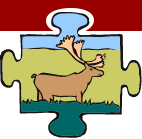CARIBOU
Indicators
- Calf/cow ratio
- Parasites/ diseases
- Number harvested
- Pregnancy rates
- Migration routes
- Habitat availability
- Energetics
- Body weight/fat
- Levels of contaminants
- Population size and trends
- Movements and distribution
- Availability of forage
- Wolf predation
|
Current Knowledge
Caribou sub-species found within the NWT include: the barren-ground caribou, the woodland caribou, and the endangered Peary caribou.
An estimated 850,000 barren-ground caribou inhabit the NWT. The NWT Government has information on distribution, population, management and economic status of major herds. At this time the caribou harvest is deemed sustainable. The barren-ground caribou of the NWT are made up of distinctive herds: the Bathurst herd is experiencing a significant decline in population; the Beverly herd size is unknown; the "Bluenose herd" is considered to be three distinct herds - the Cape Bathurst, Bluenose-West and Bluenose-East herds; the Porcupine herd is declining in size, likely due to weather conditions. Development and industrial activities in calving areas are a major concern to the Porcupine herd population.
Woodland caribou are also called Boreal and Northern Mountain caribou. Little is know about Boreal caribou, but they are found at low densities and live in small groups on specific land types. Therefore, their population is vulnerable to changes in habitat. There are three areas in the Deh Cho that have been proposed as Protected Areas for Boreal caribou. Northern Mountain caribou occur in herds; they migrate north of the treeline in late winter. The overall herd size is unknown. Efforts are on-going to conserve Northern Mountain caribou habitat. Genetic diversity analysis is also underway on boreal caribou in different geographic areas.
Overall, Peary caribou populations have declined since 1961. They are nationally classified as Endangered. Key indicators for these herds are population trends and physical condition of the caribou.
Caribou migration patterns have changed in the scale of tens of kilometres; it is not known whether this is due to natural or manmade changes at the landscape scale. Changes to the condition of caribou are uncertain at this time. Contaminant levels in caribou are low in the NWT and are not a human health or food consumption concern.
Current Monitoring
- General Status Ranks of Wild Species in the Northwest Territories - Government of the Northwest Territories (GNWT)
- Heavy metals and radionuclide contaminants in caribou - GNWT
- Community-based monitoring - Arctic Borderlands Ecological Knowledge Co-op
Bathurst Herd:
- West Kitikmeot Slave Study - West Kitikmeot Slave Study Society
- Seasonal movements the of Bathurst caribou herd - GNWT
- Bathurst caribou calving ground studies: Influence of nutrition and human activity on calving ground location - University of Alaska, GNWT, Canadian Wildlife Service
- Traditional knowledge on the relationship between caribou migration patterns and the state of caribou habitat - Dogrib Treaty 11 Council
- Tuktu and Nogak Project: Inuit knowledge about wildlife in Bathurst Inlet - Simon Fraser University and Tuktu and Nogak Board
- Bathurst caribou herd calving ground surveys - GNWT
- Wildlife effects monitoring program - BHP Diamonds Inc.
- Wildlife/habitat Monitoring - Diavik Diamond Mines Inc.
Cape Bathurst, Bluenose-East and Bluenose-West Herds:
- Cape Bathurst and Bluenose-West caribou spring composition counts - GNWT
- Cape Bathurst and Bluenose-West body condition - GNWT
- Cape Bathurst, Bluenose-West and Bluenose-East caribou census - GNWT
- Cape Bathurst, Bluenose-West and Bluenose-East satellite tracking - GNWT
Porcupine Herd:
- Porcupine caribou composition counts - Yukon Territorial Government (YTG)
- Porcupine caribou body condition - YTG
- Porcupine caribou herd census - YTG
- Porcupine caribou herd total estimated harvest - YTG
- Porcupine caribou herd movements and distribution - YTG
Woodland (Boreal and Northern Mountain Caribou):
- Boreal caribou research program - Boreal Caribou Committee
- Ecology of boreal woodland caribou in the Gwich'in Settlement Area - GNWT
- Survey of boreal caribou area of occupation
- Ecology of mountain woodland caribou in the north Mackenzie Mountains - Sahtu Renewable Resources Board and GNWT
- Population trend in the Cameron Hills area - RWED
- Trout Lake-Celebita Lake area monitoring program
- Satellite collar program for Northern Mountain caribou on the NT/YT border - Parks Canada, YTG and Wildlife Conservation Society
- Annual harvest monitoring of Northern Mountain caribou in the Mackenzie Mountains
Peary Caribou and Dolphin and Union Herd:
- Peary caribou population surveys - GNWT
- On-going satellite tracking to monitor seasonal movements and distribution - GNWT
Gaps and Recommendations
Baseline information on the threatened Boreal caribou and their habitat is unavailable. Therefore, expanding the monitoring of trends in Boreal caribou populations would be useful. The implications of global warming, especially for the relationship between moose, wolf predation and boreal caribou is unknown. Cumulative effects for the Bathurst caribou herd are unknown relative to mining activity; cumulative effects are also unknown in the three Bluenose herds and Porcupine herds relative to oil and gas exploration and development.
Monitoring programs for the Ahiak and Beverly herds which currently winter in the Northwest Territories are needed. There is an absence of information to discriminate between effects of environmental variation and human activities. More information could be gathered on contaminants, parasites and diseases in Boreal and Mountain caribou.
Consider applying management, monitoring and modeling techniques for the Porcupine caribou herd to the Bathurst, Bluenose East and West, Ahiak and Beverly herds in the Northwest Territories.
This summary is based on: A Preliminary State of Knowledge of Valued Components for the NWT Cumulative Impact Monitoring Program (NWT CIMP) and Audit. February 1, 2002; updated February 2005.
For more details, you may also want to look at:
-
Caribou Excerpt
-
VC State of Knowledge Full Report
-
Projects on Caribou
- NWT Environmental Audit 2005 - Supplementary Report on the Status of the Environment
Top of page


